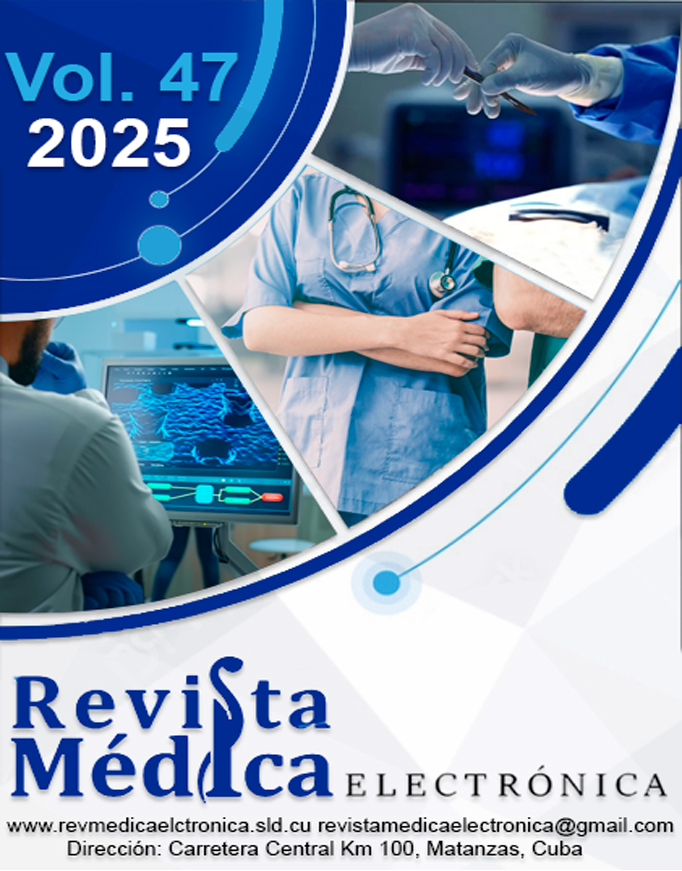Resilience in health entrepreneurship: changes and challenges in the post-COVID-19 context
Keywords:
entrepreneurship, healthcare sector, needs, expectations, resilienceAbstract
Introduction: The COVID-19 pandemic significantly transformed the healthcare entrepreneurial ecosystem, and generated new challenges and opportunities, which requires studies that evaluate various aspects of healthcare system management.
Objective: To analyze changes in healthcare sector priorities, assess the resilience of initiatives, and determine the adaptation strategies implemented.
Methods: A validated questionnaire was administered to entrepreneurs from various healthcare areas; variables such as infrastructure, financing, digitalization, and innovation were analyzed. Data were processed using descriptive and inferential statistics.
Results: The results revealed that the pandemic accelerated the adoption of digital technologies, promoted new innovation strategies, and altered growth expectations. However, barriers persist related to access to financing, bureaucratic regulations, and the consolidation of support networks. Entrepreneurial resilience was evident in the ability of business to remain operational and in the motivation of entrepreneurs to continue their activities.
Conclusions: Although the healthcare sector has demonstrated a remarkable capacity for adaptation, it is necessary to strengthen support policies to ensure its sustainability. Digitalization and income diversification emerged as key factors for the recovery and expansion of the sector. This study provides a foundation for future research on innovation and sustainability in healthcare entrepreneurship.
Downloads
References
1. Chirinos Araque YV, Meriño Córdoba VH, Martínez de Meriño CY, et al. Emprendimiento sostenible para el desarrollo económico de las PYMES. Espacios [Internet]. 2018 [citado 14/01/2025];39(7). Disponible en: https://www.revistaespacios.com/a18v39n07/18390703.html
2. Veselinovic D, Antoncic JA, Antoncic B, et al. Financial self-efficacy of entrepreneurs and performance. J Dev Entrep. 2022;27(01). DOI: 10.1142/S1084946722500029.
3. Cicea C, Popa I, Marinescu C, et al. Determinants of SMEs’ performance: evidence from European countries. Econ Res-Ekon Istraz. 2019;32(1):1602-20. DOI: 10.1080/1331677X.2019.1636699.
4. Rhyan C, Turner A, Miller G. Tracking the US health sector: The impact of the COVID-19 pandemic. Bus Econ. 2020;55(4):267-8. DOI: 10.1057/s11369-020-00195-z.
5. Kadar B, Reicher RZ. Innovations in health care management: the effect of the pandemic on the labour market change. Mark Manag Innov. 2020;(4):120-30. DOI: 10.21272/mmi.2020.4-09.
6. Callegari B, Feder C. Entrepreneurship and the systemic consequences of epidemics: a literature review and emerging model. Int Entrep Manag J. 2022;18(4):1653-84. DOI: 10.1007/s11365-021-00790-2.
7. Gai Y, Crocker A, Brush C, et al. How healthcare entrepreneurship enhances ecosystem outcomes: the relationship between venture capital-funded start-ups and county-level health. Int J Entrep Behav Res. 2024;30(8):1977-2000. DOI: 10.1108/IJEBR-02-2023-0204.
8. Rodríguez Torres ÁF, Páez Granja RE, Altamirano Vaca EJ, et al. Nuevas perspectivas educativas orientadas a la promoción de la salud. Educ Méd Super [Internet]. 2017 [citado 14/01/2025];31(4). Disponible en: https://ems.sld.cu/index.php/ems/article/view/1366
9. Sagarra-Romero L, Ruidiaz Peña M, Monroy Antón A, et al. ithlete Heart Rate Variability app: knowing when to train. Br J Sports Med. 2017;51(18). DOI: 10.1136/bjsports-2016-097303.
10. Gadea-Uribarri H, Lago-Fuentes C, Bores-Arce A, et al. External Load Evaluation in Elite Futsal: Influence of Match Results and Game Location with IMU Technology. J Funct Morphol Kinesiol. 2024;9(3):140. DOI: 10.3390/jfmk9030140.
11. Балановская АВ, Balanovskaya AV, Gerasimov KB. Tools for improvement of the ecological environment for innovative entrepreneurship of the medical device industry. Econ Manag. 2021;12(4):27-36. DOI: 10.18287/2542-0461-2021-12-4-27-36.
12. Muo I. Social Entrepreneurship and medical entrepreneurship: Lessons from Nigeria. En: Raimi L, Oreagba IA. Medical Entrepreneurship. Singapore: Springer Nature; 2023. DOI: 10.1007/978-981-19-6696-5_11.
13. Fernández-Lorenzo A, Pérez-Rico C, Méndez-Rojas VE, et al. El marketing social y su influencia en la solución de problemas de salud. Rev Cubana Inv Bioméd [Internet]. 2017 [citado 14/01/2025];36(3). Disponible en: https://revibiomedica.sld.cu/index.php/ibi/article/view/79
14. Kechagioglou P. Learning from Innovation Success—A Case Study. En: Healthcare Innovation Success. Cham: Springer Nature; 2023. DOI: 10.1007/978-3-031-28353-6_4.
15. Fernández Lorenzo A, Arias Puedmag DE, Padilla Oyos CR, et al. Alianzas y conflictos entre grupos de interés de un hospital militar: aplicación del método Mactor. Rev Cubana Inv Bioméd [Internet]. 2017 [citado 14/01/2025];36(1). Disponible en: https://revibiomedica.sld.cu/index.php/ibi/article/view/39
16. Vera Ortiz JG, Vera Barzola AX, Parrales Poveda ML. Crisis económica del ecuador: una mirada al sector microempresarial post covid-19: Crisis económica del ecuador. UNESUM-Ciencias. 2020;4(4):1-14. DOI: 10.47230/unesum-ciencias.v4.n3.2020.317.
17. Zupic I, Cater T, Pustovrh A. Barriers to growth in entrepreneurial ecosystems. Valhalla, NYA: Academy of Management Proceedings; 2017. DOI: 10.5465/AMBPP.2017.15202abstract.
18. Meiling L, Yahya F, Waqas M, et al. Boosting sustainability in healthcare sector through Fintech: analyzing the moderating role of financial and ICT development. INQUIRY. 2021;58. DOI: 10.1177/00469580211028174.
19. Orozco-Cazco GH, Cabezas-González M, Martínez-Abad F, et al. Variables sociodemográficas que inciden en las competencias digitales del profesorado universitario. Chakiñan. 2020;12:32-48. DOI: 10.37135/chk.002.12.02.
20. Čizmić E, Šestić M, Hrnjic A, et al. Magnitude of Covid-19 Pandemic Impact on Entrepreneurial Companies’ Operations in Developing Countries. En: Karabegović I. New Technologies, Development and Applications IV. Cham: Springer Nature; 2021. DOI: 10.1007/978-3-030-75275-0_124.
21. Moss J. Experience sampling methods in critical event studies: Theory and practice. En: Lamond I, Platt L. Critical event studies. Leisure Studies in a Global Era. London: Palgrave Macmillan; 2016. DOI: 10.1057/978-1-137-52386-0_13.
22. Almanza Santana L, Soler Cárdenas S, Mesa Simpson C, et al. El uso de las nuevas tecnologías de la información y las comunicaciones por los profesores de las ciencias médicas en Matanzas. Rev Méd Electrón [Internet]. 2021 [citado 14/01/2025];43(1):2917-27. Disponible en: http://scielo.sld.cu/scielo.php?script=sci_arttext&pid=S1684-18242021000102917
23. Almeida-Campos S. Los cambios tecnológicos y el rechazo de artículos en la Revista Médica Electrónica. Rev Méd Electrón [Internet]. 2022 [citado 14/01/2025];44(3):465-7. Disponible en: https://www.medigraphic.com/pdfs/revmedele/me-2022/me223a.pdf
24. Omarov B, Omarov B, Rakhymzhanov A, et al. Development of an artificial intelligence-enabled non-invasive digital stethoscope for monitoring the heart condition of athletes in real-time. Retos. 2024;60:1169-80. DOI: 10.47197/retos.v60.108633.
25. Pardos-Mainer E, Calero Morales S, Sagarra L. Efectos de las plataformas vibratorias en la salud ósea en mujeres posmenopáusicas. Rev cuba obstet ginecol [Internet]. 2019 [citado 14/01/2025];45(1):118-36. Disponible en: https://revginecobstetricia.sld.cu/index.php/gin/article/view/e424
26. Azhibekova Z, Altayeva A, Amirtayeva A, et al. Advancing athlete safety through real-time ECGmonitoring for enhanced cardiovascular health in sports performance. Retos. 2024;61:1333-43. DOI: 10.47197/retos.v61.110378.
27. Roman-Huera CK, Vinueza-Martínez CN, Portilla-Paguay GV, et al. Tecnología y Cuidados de Enfermería: Hacia una Práctica Innovadora y Sostenible. J Econ Soc Sci Res. 2024;4(1):99-121. DOI: 10.55813/gaea/jessr/v4/n1/89.
Downloads
Published
How to Cite
Issue
Section
License
Copyright (c) 2025 María Stefanie Vásquez-Peñafiel, María Rosario Perello-Marín

This work is licensed under a Creative Commons Attribution-NonCommercial 4.0 International License.
All content published in this journal is Open Access, distributed under the terms of the CC BY-NC 4.0 License.
It allows:
- Copy and redistribute published material in any medium or format.
- Adapt the content.
This will be done under the following terms:
- Attribute the authors' credits and indicate whether changes were made, in which case it must be in a reasonable way.
- Non-commercial use.
- Recognize the journal where it is published.
The copyrights of each article are maintained, without restrictions.






